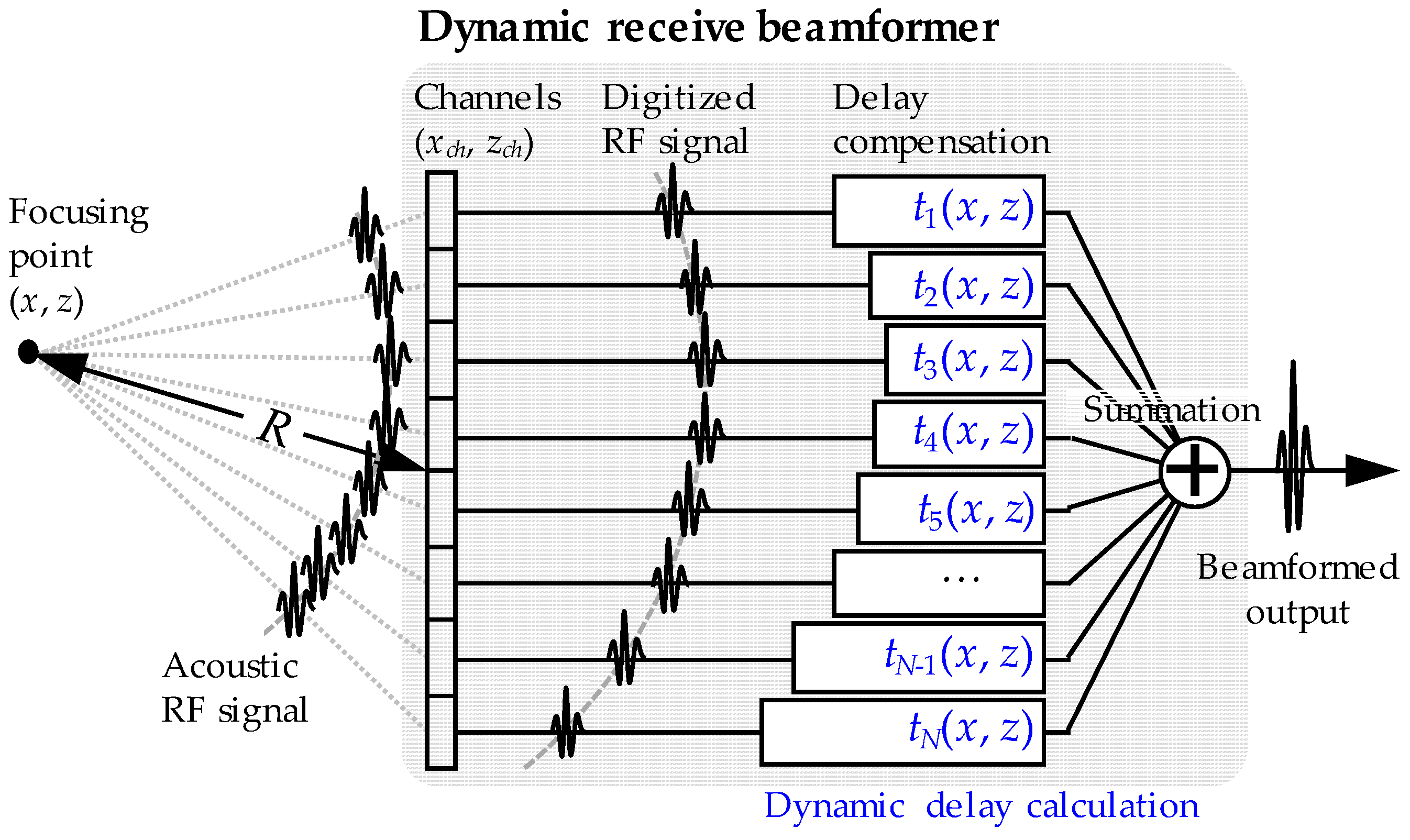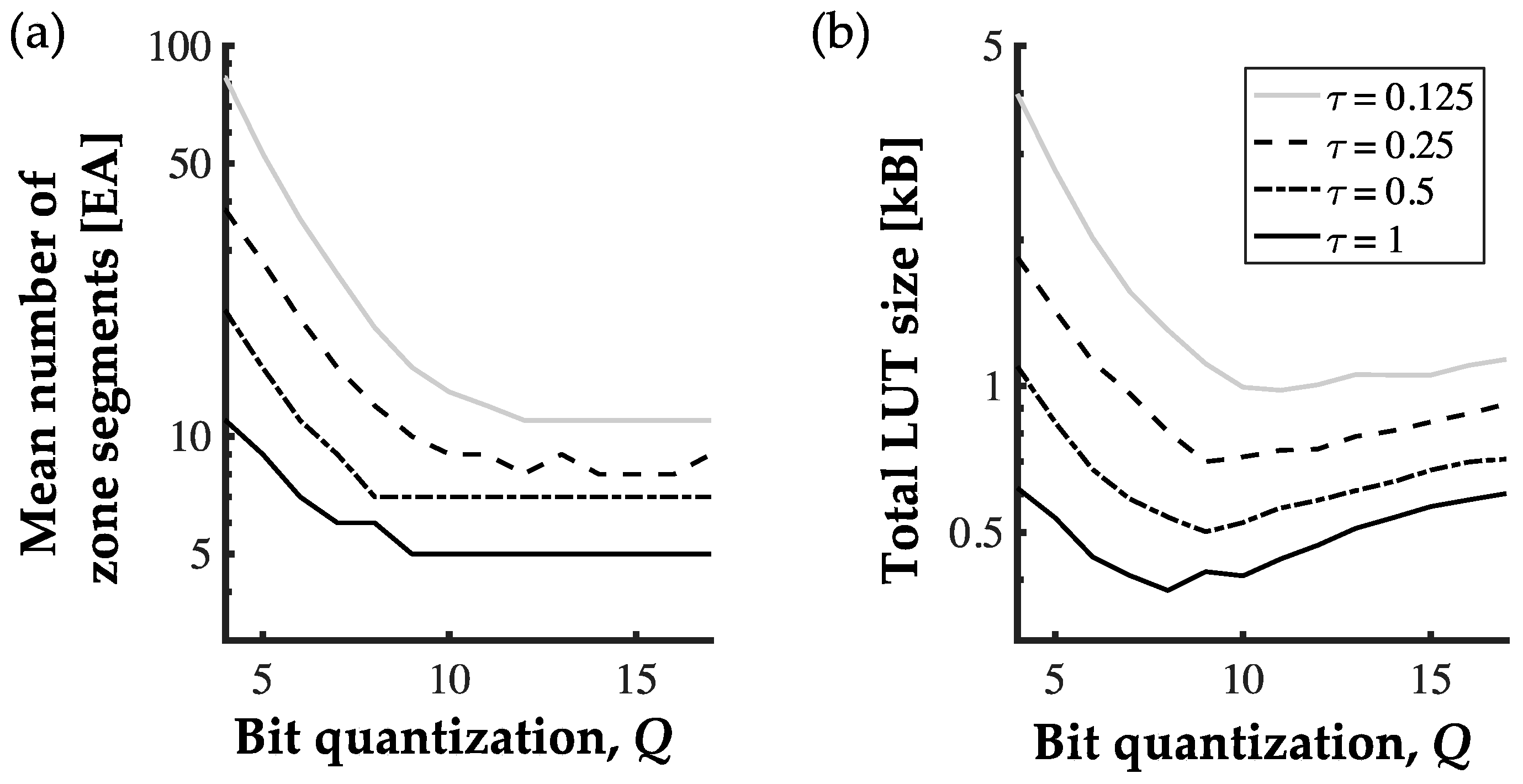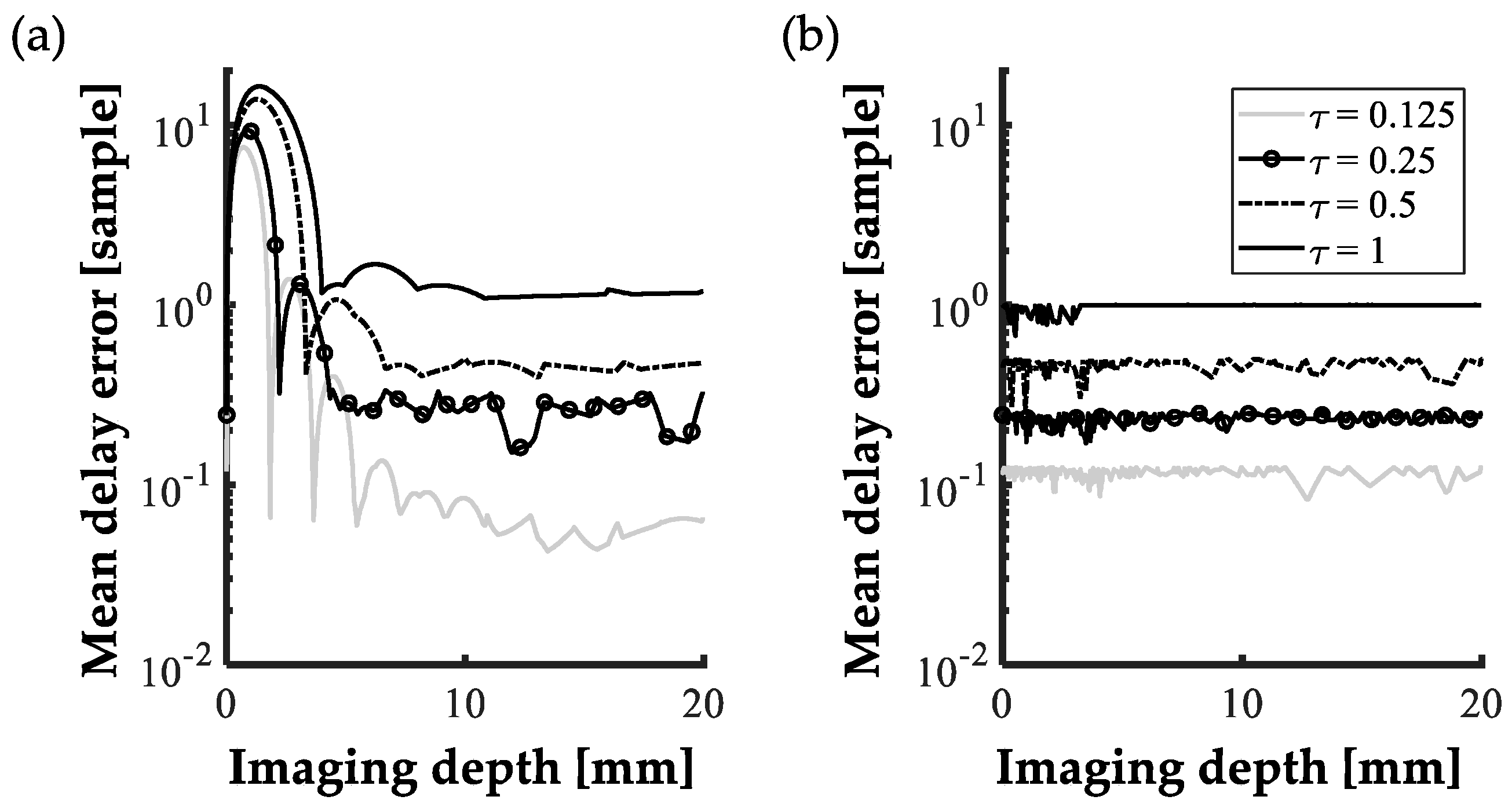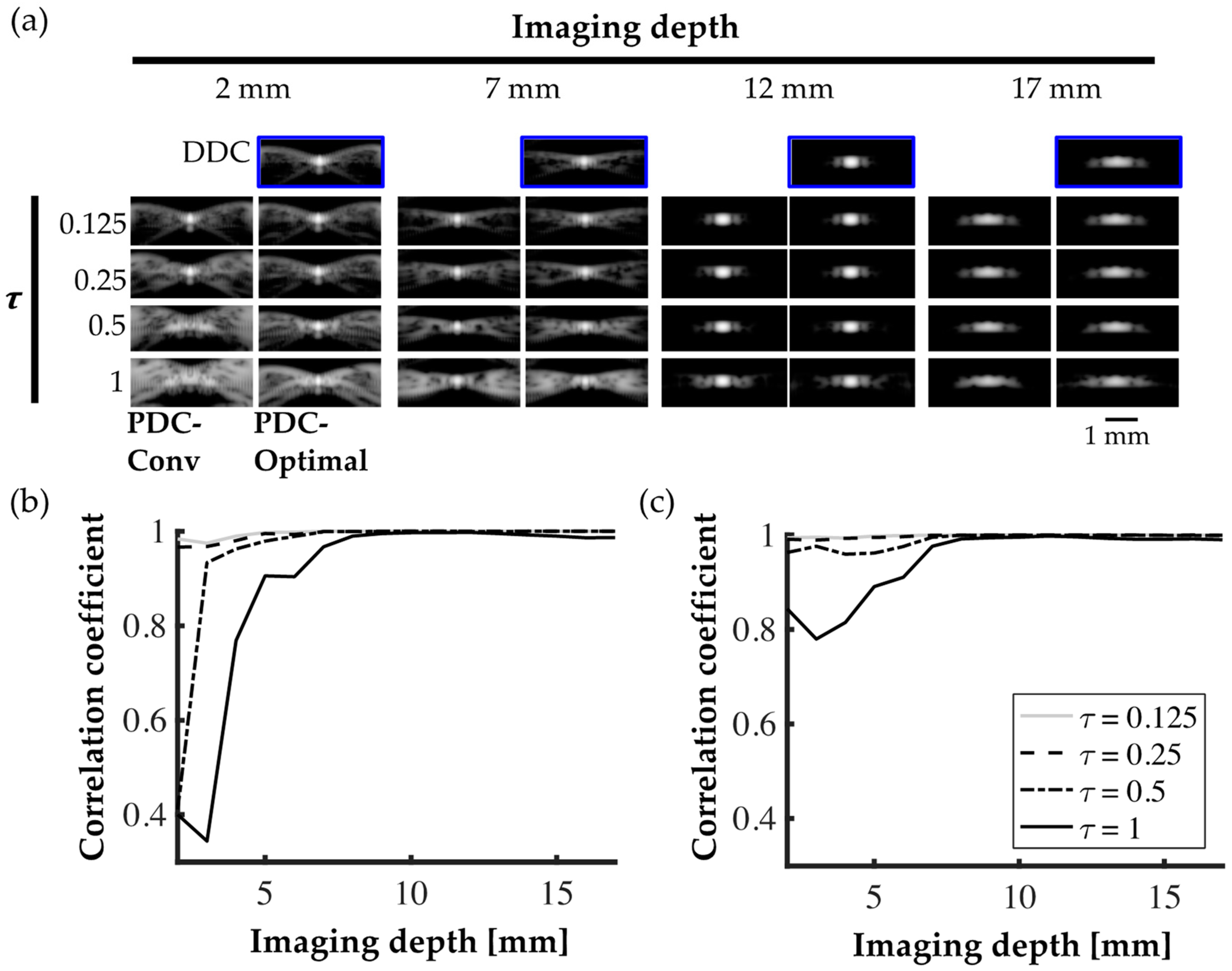A Pseudo-Dynamic Delay Calculation Using Optimal Zone Segmentation for Ultra-Compact Ultrasound Imaging Systems
Abstract
:1. Introduction
2. Materials and Methods
2.1. Dynamic Delay Calculation for Diagnostic U2.3ltrasound
2.2. Pseudo-Dynamic Delay Calculation (PDC) Using Optimal Zone Segmentation
2.3. Simulation Setup
3. Results
4. Discussion and Conclusion
Author Contributions
Funding
Conflicts of Interest
Abbreviations
| DDC | dynamic delay calculations |
| PDC | pseudo-dynamic delay calculations |
| FF | flip-flop |
| LUT | look-up-table |
| LVDS | low-voltage differential signaling |
| LVCMOS | low-voltage complementary metal oxide semiconductor |
| PDC-TS | time-sharing pseudo-dynamic delay calculations |
| PDC-Conv | conventional pseudo-dynamic delay calculations using uniform zone segmentation |
| PDC-Optimal | pseudo-dynamic delay calculations using an optimal zone segmentation with non-uniform intervals |
| US | ultrasound |
| ADC | analog-to-digital conversion |
| RTC | real-time controller |
| RF | radio-frequency signal |
| FPGA | field programmable gated array |
| PSF | point-spread function |
| CC | correlation coefficient |
| PA | photoacoustic |
References
- Moore, C.L.; Copel, J.A. Point-of-care ultrasonography. N. Engl. J. Med. 2011, 364, 749–757. [Google Scholar] [CrossRef] [PubMed]
- Kim, G.-D.; Yoon, C.; Kye, S.-B.; Lee, Y.; Kang, J.; Yoo, Y.; Song, T.-K. A single FPGA-based portable ultrasound imaging system for point-of-care applications. IEEE Trans. Ultrason. Ferroelectr. Freq. Control 2012, 59, 1386–1394. [Google Scholar] [PubMed]
- Shin, B.; Jeon, S.; Ryu, J.; Kwon, H.J. Elastography for portable ultrasound. Biomed. Eng. Lett. 2017, 8, 101–116. [Google Scholar] [CrossRef] [PubMed]
- Di Ianni, T.; Hoyos, C.A.V.; Ewertsen, C.; Kjeldsen, T.K.; Mosegaard, J.; Nielsen, M.B.; Jensen, J.A. A Vector Flow Imaging Method for Portable Ultrasound Using Synthetic Aperture Sequential Beamforming. IEEE Trans. Ultrason. Ferroelectr. Freq. Control 2017, 64, 1655–1665. [Google Scholar] [CrossRef] [PubMed]
- George, S.S.; Huang, M.C.; Ignjatovic, Z. Portable ultrasound imaging system with super-resolution capabilities. Ultrasonics 2018, in press. [Google Scholar] [CrossRef] [PubMed]
- George, S.; Anand, A.; Mitrovic, J.; Ignjatovic, Z. Low-complexity compressive beamforming for portable ultrasound imaging. In Proceedings of the 2017 IEEE International Ultrasonics Symposium (IUS), Washington, DC, USA, 6–9 September 2017. 17318162. [Google Scholar] [CrossRef]
- Kim, J.H.; Yeo, S.; Kim, J.W.; Kim, K.; Song, T.-K.; Yoon, C.; Sung, J. Real-Time Lossless Compression Algorithm for Ultrasound Data Using BL Universal Code. Sensors 2018, 18, 3314. [Google Scholar] [CrossRef] [PubMed]
- Szasz, T.; Basarab, A.; Vaida, M.-F.; Kouamé, D. Elastic-net based beamforming in medical ultrasound imaging. In Proceedings of the 2016 IEEE 13th International Symposium on Biomedical Imaging (ISBI), Prague, Czech Republic, 13–16 April 2016; pp. 477–480. [Google Scholar]
- Byram, B.; Dei, K.; Tierney, J.; Dumont, D. A model and regularization scheme for ultrasonic beamforming clutter reduction. IEEE Trans. Ultrason. Ferroelectr. Freq. Control 2015, 62, 1913–1927. [Google Scholar] [CrossRef] [PubMed]
- China, D.; Tom, F.; Nandamuri, S.; Kar, A.; Srinivasan, M.; Mitra, P.; Sheet, D. UltraCompression: Framework for High Density Compression of Ultrasound Volumes using Physics Modeling Deep Neural Networks. arXiv, 2019; arXiv:1901.05880. Available online: https://arxiv.org/abs/1901.05880v1(accessed on 10 February 2019).
- Kang, J.; Yoon, C.; Lee, J.; Kye, S.-B.; Lee, Y.; Chang, J.H.; Kim, G.-D.; Yoo, Y.; Song, T.-K. A System-on-Chip Solution for Point-of-Care Ultrasound Imaging Systems: Architecture and ASIC Implementation. IEEE Trans. Biomed. Circuits Syst. 2016, 10, 1. [Google Scholar] [CrossRef] [PubMed]
- Mucci, R. A comparison of efficient beamforming algorithms. IEEE Trans. Acoust. Speech Signal Process. 1984, 32, 548–558. [Google Scholar] [CrossRef]
- Sohn, H.-Y.; Kang, J.; Cho, J.; Song, T.-K.; Yoo, Y. Time-sharing bilinear delay interpolation for ultrasound dynamic receive beamformer. Electron. Lett. 2011, 47, 89–91. [Google Scholar] [CrossRef]
- Yoon, C.; Kim, H.H.; Shung, K.K. Development of a Low-Complexity, Cost-Effective Digital Beamformer Architecture for High-Frequency Ultrasound Imaging. IEEE Trans. Ultrason. Ferroelectr. Freq. Control 2017, 64, 1002–1008. [Google Scholar] [PubMed]
- Cho, J.; Lee, J.-Y.; Song, J.-H.; Kim, Y.; Song, T.-K. A fractional filter-based beamformer architecture using postfiltering approach to minimize hardware complexity. IEEE Trans. Ultrason. Ferroelectr. Freq. Control 2007, 54, 1076–1079. [Google Scholar] [CrossRef] [PubMed]
- Li, P.-C.; Huang, J.-J.; Liu, H.-L.; O’Donnell, M. A Dynamic Focusing Technique for Delta-Sigma-Based Beamformers. Ultrason Imaging 2000, 22, 197–205. [Google Scholar] [CrossRef] [PubMed]
- Fink, M.; Kuperman, W.A.; Montagner, J.-P.; Tourin, A. (Eds.) Imaging of Complex Media with Acoustic and Seismic Waves; Springer: Berlin/Heidelberg, Germany, 2002; pp. 135–166. [Google Scholar]
- Lee, Y.; Kang, J.; Yeo, S.; Lee, J.; Kim, G.-D.; Yoo, Y.; Song, T.-K. A new smart probe system for a tablet PC-based point-of-care ultrasound imaging system: Feasibility study. In Proceedings of the 2014 IEEE International Ultrasonics Symposium, Chicago, IL, USA, 3–6 September 2014. 14698497. [Google Scholar] [CrossRef]
- Ahn, S.; Kang, J.; Kim, P.; Lee, G.; Jeong, E.; Jung, W.; Park, M.; Song, T.-K. Smartphone-based portable ultrasound imaging system: Prototype implementation and evaluation. In Proceedings of the 2015 IEEE International Ultrasonics Symposium (IUS), Taipei, Taiwan, 21–24 October 2015. 15601699. [Google Scholar] [CrossRef]
- Jeong, E.; Bae, S.; Park, M.; Jung, W.; Kang, J.; Song, T.-K. Color Doppler imaging on a smartphone-based portable US system: Preliminary study. In Proceedings of the 2015 IEEE International Ultrasonics Symposium (IUS), Taipei, Taiwan, 21–24 October 2015. [Google Scholar] [CrossRef]
- Churiwala, S. (Ed.) Designing with Xilinx® FPGAs: Using Vivado; Springer: Cham, Switzerland, 2017; pp. 237–249. [Google Scholar]
- Wang, L.V.; Hu, S. Photoacoustic Tomography: In Vivo Imaging from Organelles to Organs. Science 2012, 335, 1458–1462. [Google Scholar] [CrossRef] [PubMed]
- Wang, L.V. Multiscale photoacoustic microscopy and computed tomography. Nat. Photonics 2009, 3, 503–509. [Google Scholar] [CrossRef] [PubMed]
- Kang, J.; Chang, J.H.; Kim, S.M.; Lee, H.J.; Kim, H.; Wilson, B.C.; Song, T.-K. Real-time sentinel lymph node biopsy guidance using combined ultrasound, photoacoustic, fluorescence imaging: in vivo proof-of-principle and validation with nodal obstruction. Sci. Rep. 2017, 7, 45008. [Google Scholar] [CrossRef] [PubMed]
- Kalva, S.K.; Upputuri, P.K.; Pramanik, M. High-speed, low-cost, pulsed-laser-diode-based second-generation desktop photoacoustic tomography system. Opt. Lett. 2019, 44, 81–84. [Google Scholar] [CrossRef]
- Upputuri, P.K.; Pramanik, M. Performance characterization of low-cost, high-speed, portable pulsed laser diode photoacoustic tomography (PLD-PAT) system. Biomed. Opt. Express 2015, 6, 4118–4129. [Google Scholar] [CrossRef]
- Daoudi, K.; van den Berg, P.J.; Rabot, O.; Kohl, A.; Tisserand, S.; Brands, P.; Steenbergen, W. Handheld probe integrating laser diode and ultrasound transducer array for ultrasound/photoacoustic dual modality imaging. Opt. Express 2014, 22, 26365–26374. [Google Scholar] [CrossRef]
- Mozaffarzadeh, M.; Mahloojifar, A.; Orooji, M.; Adabi, S.; Nasiriavanaki, M. Double-Stage Delay Multiply and Sum Beamforming Algorithm: Application to Linear-Array Photoacoustic Imaging. IEEE Trans. Biomed. Eng. 2018, 65, 31–42. [Google Scholar] [CrossRef]
- Mozaffarzadeh, M.; Mahloojifar, A.; Orooji, M.; Kratkiewicz, K.; Adabi, S.; Nasiriavanaki, M. Linear-array photoacoustic imaging using minimum variance-based delay multiply and sum adaptive beamforming algorithm. J. Biomed. Opt. 2018, 23, 026002. [Google Scholar] [CrossRef] [PubMed]
- Omidi, P.; Zafar, M.; Mozaffarzadeh, M.; Hariri, A.; Haung, X.; Orooji, M.; Nasiriavanaki, M. A Novel Dictionary-Based Image Reconstruction for Photoacoustic Computed Tomography. Appl. Sci. 2018, 8, 1570. [Google Scholar] [CrossRef]
- Kang, J.; Kim, E.-K.; Kim, G.R.; Yoon, C.; Song, T.-K.; Chang, J.H. Photoacoustic imaging of breast microcalcifications: a validation study with 3-dimensional ex vivo data and spectrophotometric measurement. J. Biophotonics 2015, 8, 71–80. [Google Scholar] [CrossRef] [PubMed]
- Kim, G.R.; Kang, J.; Kwak, J.Y.; Chang, J.H.; Kim, S., II; Youk, J.H.; Moon, H.J.; Kim, M.J.; Kim, E.-K. Photoacoustic Imaging of Breast Microcalcifications: A Preliminary Study with 8-Gauge Core-Biopsied Breast Specimens. PLoS ONE 2014, 9, e105878. [Google Scholar] [CrossRef] [PubMed]
- Kang, J.; Kim, E.-K.; Kwak, J.Y.; Yoo, Y.; Song, T.-K.; Chang, J.H. Optimal laser wavelength for photoacoustic imaging of breast microcalcifications. Appl. Phys. Lett. 2011, 99, 153702. [Google Scholar] [CrossRef]
- Rao, B.; Zhang, R.; Li, L.; Shao, J.-Y.; Wang, L.V. Photoacoustic imaging of voltage responses beyond the optical diffusion limit. Sci. Rep. 2017, 7, 2560. [Google Scholar] [CrossRef]
- Kang, J.; Zhang, H.K.; Kadam, S.D.; Fedorko, J.; Valentine, H.; Malla, A.P.; Yan, P.; Harraz, M.M.; Kang, J.U.; Rahmim, A.; et al. Transcranial recording of electrophysiological neural activity in the rodent brain in vivo using functional photoacoustic imaging of near-infrared voltage-sensitive dye. bioRxiv 2019. Available online: https://www.biorxiv.org/content/10.1101/202408v10 (accessed on 12 January 2019). [CrossRef]
- Nasiriavanaki, M.; Xia, J.; Wan, H.; Bauer, A.Q.; Culver, J.P.; Wang, L.V. High-resolution photoacoustic tomography of resting-state functional connectivity in the mouse brain. PNAS 2014, 111, 21–26. [Google Scholar] [CrossRef]





| Method | DDC | PDC-TS | |||||
|---|---|---|---|---|---|---|---|
| 0.125 | 0.25 | 0.5 | 1 | ||||
| Hardware resource | FF | 20,972 | 3108 | 3283 | 2956 | 2886 | 2678 |
| LUT | 45,059 | 3769 | 2616 | 2330 | 2173 | 1902 | |
| Dynamic power (mW) | 402 | 40 | 32 | 27 | 24 | 22 | |
© 2019 by the authors. Licensee MDPI, Basel, Switzerland. This article is an open access article distributed under the terms and conditions of the Creative Commons Attribution (CC BY) license (http://creativecommons.org/licenses/by/4.0/).
Share and Cite
Kim, P.; Kang, J.; Song, T.-K. A Pseudo-Dynamic Delay Calculation Using Optimal Zone Segmentation for Ultra-Compact Ultrasound Imaging Systems. Electronics 2019, 8, 242. https://doi.org/10.3390/electronics8020242
Kim P, Kang J, Song T-K. A Pseudo-Dynamic Delay Calculation Using Optimal Zone Segmentation for Ultra-Compact Ultrasound Imaging Systems. Electronics. 2019; 8(2):242. https://doi.org/10.3390/electronics8020242
Chicago/Turabian StyleKim, Pilsu, Jeeun Kang, and Tai-Kyong Song. 2019. "A Pseudo-Dynamic Delay Calculation Using Optimal Zone Segmentation for Ultra-Compact Ultrasound Imaging Systems" Electronics 8, no. 2: 242. https://doi.org/10.3390/electronics8020242
APA StyleKim, P., Kang, J., & Song, T.-K. (2019). A Pseudo-Dynamic Delay Calculation Using Optimal Zone Segmentation for Ultra-Compact Ultrasound Imaging Systems. Electronics, 8(2), 242. https://doi.org/10.3390/electronics8020242






